Iceberg A-68: The story of how a mega-berg transformed the ocean
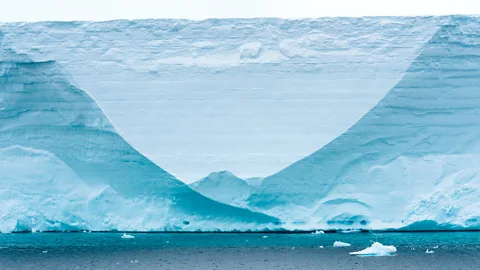 Getty Images
Getty ImagesThe world's largest icebergs – which can be larger than entire countries in some cases – break off the Antarctic ice sheet. As they drift and melt in the Southern Ocean, they create a unique environment around them.
It began with a crack. A very, very large one.
In late 2016, scientists spotted a rapidly growing fissure extending across the enormous Larsen C Ice Shelf that spills into the Weddell Sea from the West Antarctica Peninsula. Within a few months, the rift led to one of the biggest icebergs ever observed breaking off into the ocean.
The gargantuan slab of ice was more than twice the size of Luxembourg, covering an area of more than 2,200 sq miles (5,700sq km) and was around 770ft (235m) thick. For a year, this monster barely moved, trapped in the seasonal embrace of the Antarctic sea ice. But then it began to accelerate north, carried by ocean currents and winds.
Iceberg A-68, as it was designated, had embarked on what would be an epic 3.5-year odyssey that took it from the Antarctic sea ice to a remote island in the Southern Ocean.
A-68 would also go on to become one of the world's most famous icebergs when, during the Christmas of 2020, its journey caught hold on social media and the world fell in love with it. Perhaps everyone was a bit stir-crazy from the Covid-19 lockdowns, but for whatever reason, the fate of iceberg A-68 as it made its way across the Southern Ocean was a sensation.
There was even the possibility of a truly dramatic ending. Ecologists worried that the vast berg might collide with the island of South Georgia, devastating local ecosystems. The remote island is a breeding ground for many threatened species including albatrosses.
Instead, the iceberg gradually broke apart and melted before the worst could happen. Over the years, it fractured into smaller pieces and released billions of tonnes of chilled, freshwater into the ocean before finally meeting its end in a slushy whimper during April 2021.
In doing so, it also transformed the marine habitat around it, creating unique conditions that support an entire ecosystem of life. Scientists following A-68's birth and demise were able to track just what such giant icebergs do to the surrounding ocean. For its short, transient life as an iceberg, A-68 became a frozen lifeboat for a wide range of species.
Now the huge volumes of data gathered about A-68 have been analysed by scientists, it's possible to tell the full story of the iceberg and the impact it had on the ocean.
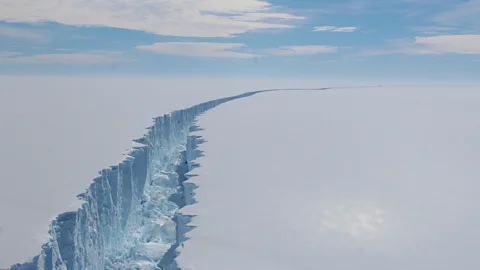 British Antarctic Survey
British Antarctic SurveyCalving from Antarctica
On the side of Antarctica closest to South America, a long strip of land extends out into the Southern Ocean. The West Antarctic Peninsula is the most habitable part of the continent, with many penguin colonies, plants and other thriving life.
Along its east coast, the peninsula is bordered by the Larsen ice shelves. These vast plains of floating glacier ice span tens of thousands of square kilometres. The seas under them are virtually unknown because the thick ice acts as a near-impassable barrier to vessels. It can be hundreds of metres thick, with all but a fraction of it being below the sea surface. This thick, frozen blanket also means the marine habitat and life below often hasn't seen sunlight for thousands of years.
But the ice sheets are not static. Gradually and inexorably, ice flows downhill from the continent and out over the sea where it meets the much thinner sea ice, which extends and retreats with the seasons. This means the shelf of continental ice sheet that protrudes over the ocean is forever being pushed out towards the open sea. Occasionally, a big chunk breaks away or "calves".
"Calving is a natural event," says Geraint Tarling, a polar ecologist at the British Antarctic Survey in Cambridge, UK.
That's exactly what happened in July 2017. The huge crack in the Larsen C ice sheet had been there for more than a decade, but in late 2016 it began to rapidly propagate causing the ice shelf to snap a few months later. A block of ice, representing about 10% of the Larsen C shelf, broke away. At the time it was the largest iceberg adrift in the ocean and the sixth largest in 30 years of records.
The US National Ice Center, which is responsible for tracking major icebergs, named the berg "A-68". The letter specifies the region from which it calved, and A-68 was the 68th iceberg of sufficient size to be tracked. However, within days a chunk broke away, so the main iceberg became known as "A-68a": the breakaway fragments were A-68b, A-68c and so on.
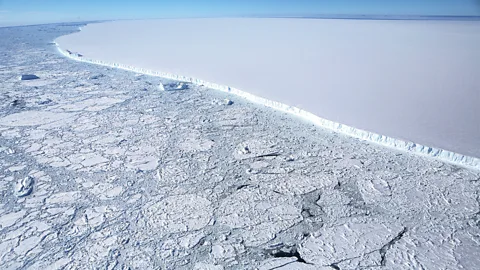 Getty Images
Getty ImagesThe journey begins
The birth of A-68 exposed a stretch of seabed that had been hidden under the ice for thousands of years. Polar scientists were eager to explore it before the ecosystems were inevitably transformed by the new situation. "There was a big move to get expeditions in there to see, once it calved and moved off, what was left," says Tarling. "Unfortunately, when it calved there was a huge amount of ice around... The opportunity was lost."
Consequently, most people forgot about A-68a for a couple of years. The huge iceberg remained trapped in position by the surrounding sea ice. In July 2018, BBC News' Jonathan Amos described it as "shuffling on the spot".
However, soon afterwards it became caught up in a circling current called the Weddell Gyre. By the following summer, it had travelled 155 miles (250km) north along the Peninsula coast.
Then it accelerated. By February 2020, as Covid-19 – and the first lockdowns – spread around the world, iceberg A-68a had reached the edge of Antarctica's year-round sea ice. It entered a region dubbed "Iceberg Alley", where powerful currents thrust icebergs northwards into the Southern Ocean.
This meant A-68a was drifting through waters warmer than anything it had so far encountered. Researchers thought it would quickly break up – and when a 67 sq mile (175 sq km) chunk fell off in April 2020, some thought a collapse was imminent. But the iceberg sailed on.
A-68a had become a near-unprecedented iceberg, says Tarling. "It was the sixth-largest ever detected," he says, and "it stayed together for an incredibly long period".
At this time, palaeoclimatologist Roseanne Smith was doing a Master's in polar and alpine change at the University of Sheffield – or rather, "I was doing it from home". Her supervisor Grant Bigg suggested she study A-68a and she began using satellite data to monitor it. "It was a case of waking up every morning and then checking where the iceberg had moved to."
Now at the British Antarctic Survey, Smith published her findings in 2023. The satellites had detected vast but thin layers of freshwater spreading across the ocean for more than 620 miles (1,000km) from the iceberg. "Satellites are only able to tell you anything about the conditions in the top few centimetres of the surface ocean," says Smith. But even in that very top layer of water they are revealing.
It's normal to find a layer of fresh water surrounding an iceberg, says Claudia Cenedese, a flow dynamicist at Woods Hole Oceanographic Institution in Massachusetts and co-author of a 2023 review of melting icebergs. "The iceberg doesn't move very fast compared to the ambient water," she says. The water melting from the surfaces of the iceberg is fresh, because it ultimately formed from snow, so it's less dense than the surrounding saltwater. "It goes to the top and it forms this meltwater pool."
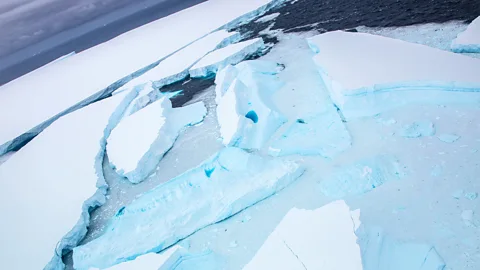 Cpl Phil Dye/RAF
Cpl Phil Dye/RAFCollision course
By the summer of 2020, Tarling and many others had realised that A-68a, if it remained intact, posed a serious danger. That's because the currents would carry it towards South Georgia, off the north-east of the tip of the Antarctic Peninsula. The island is at the heart of a Marine Protected Area that spans 500,000 sq miles (1.24 million sq km).
"South Georgia is an incredibly rich, dynamic marine ecosystem," says Tarling. "The reason for that is that the glaciers and the land run-off fertilises the ocean around it." This allows photosynthetic plankton to thrive in the waters around South Georgia, supporting Antarctic krill and a rich web of larger animals. "There are some valuable fisheries around there for toothfish and icefish, which have to be carefully managed." Furthermore, the land is home to breeding colonies of several threatened species including elephant seals, king penguins and wandering albatrosses.
A huge iceberg was the last thing the South Georgia ecosystem needed. "We were particularly concerned with this iceberg coming into this area," says Tarling. For one thing, A-68a was deep enough to scour the shallow seabed around the island, gouging away the diverse ecosystems living there. It could even ground itself just offshore, blocking breeding animals like seals from heading out to sea just when they needed to do so to obtain food for their young. "That probably would mean that there would be low levels of survival at those colonies for that particular year." This had happened in 2004 when an iceberg called A-38b grounded itself off South Georgia for months.
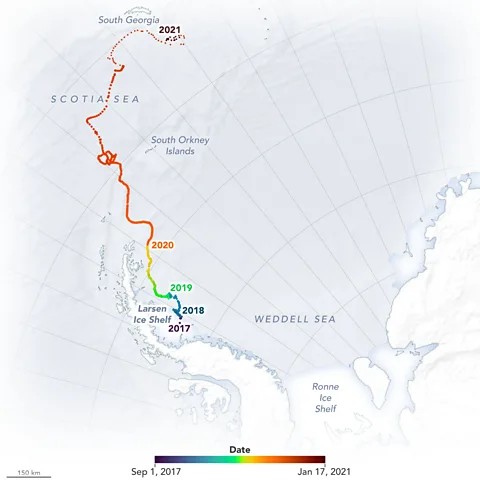 Nasa
NasaIf that weren't enough, the iceberg would also change the chemical makeup of the seawater, simply because it was mostly fresh water. "Bringing huge amounts of fresh water into an environment could really change the ecosystem from the bottom up," says Tarling.
So in the summer of 2020 Tarling started trying to arrange an expedition to the iceberg. Doing so on short notice is "not easy", he says. "But we did take advantage of the fact that there was an expedition going in and around that area anyway, for completely different purposes." Tarling arranged for the RRS James Cook to be diverted to A-68a in February 2021, though he had to stay at home because of the pandemic. He and his colleagues devised a plan for the ship to transect the freshwater layer around the iceberg, measuring water conditions and marine life as it went.
Collapse
Then in December 2020, "the iceberg started to collapse," he says. Satellite imagery at the start of the month revealed that A-68a was "fraying at the edges", "riven with cracks" and shedding chunks of ice.
Over the next two weeks, it crept towards South Georgia. "It got very, very close," says Tarling. One corner of the iceberg became wedged on the continental shelf, in the shallow waters near the island. "That bit got stuck. The rest of the iceberg snapped off." The lodged ice gouged out an area of the seabed. "We still haven't been back to investigate how bad that was," says Tarling. Still, he calls it "a lucky escape".
A few days later, A68a shattered into several fragments – albeit still large enough to affect their surroundings. A study published the following year found that this second break-up was caused by powerful ocean currents. One part of the iceberg was exposed to a fast-moving current while a neighbouring section was sat in a slower current. This created a powerful shearing effect that broke off a "finger" of ice from the iceberg's southern side. No iceberg has been seen breaking up for this reason before.
The breakup meant Tarling's team had to throw out their measurement plans and draw up new ones on the fly. But the hassle was worth it, because the situation was now even more interesting. "There have been measurements around icebergs before," he says, but "there hasn't been any measurements around a collapsing iceberg before."
Another large fragment broke away in late January 2021, not long before the RRS James Cook arrived. The researchers deployed robot gliders, which could move in amongst the huge chunks of ice. The main ship had to maintain a safe distance, sampling the seawater. "Getting measurements near icebergs is dangerous," says Cenedese.
The iceberg had also started to melt dramatically. As it spent time in the relatively warmer waters of the north Scotia Sea around South Georgia, A-68a was thinning by around 23ft (7m) a month.
The rest of A-68a was carried back out to sea in the powerful currents circling South Georgia. "Then it got taken off into the sea a little bit more, and that's where it collapsed," says Tarling.
By mid-April 2021, only fragments were left. "The largest piece became so small that it was no longer officially tracked as a giant iceberg," says Smith.
Over its three-and-a-half-year journey since it broke away from the Antarctic ice shelf, A-68 lost 802 billion tonnes of ice as it thinned from an average thickness of 770ft (235m) to 551ft (168m). Over a three-month period at the end of 2020 and start of 2021, it dumped an estimated 152 billion tonnes of fresh water into the ocean – that is equivalent to almost 61 million Olympic-sized swimming pools. At the peak of its breakup, around 1.5 billion tonnes of fresh water was gushing into the ocean every day.
The effect this would have on the ocean ecosystem was profound.
 Cpl Phil Dye/RAF
Cpl Phil Dye/RAFA unique ecosystem
Icebergs create unique and unusual temporary ecosystems around themselves – A-68 did so on a huge scale. In the surface water around the iceberg, Tarling and his colleagues found elevated levels of nutrients, including nitrate and phosphate. The concentrations were more typical of what is found in deeper waters. What seems to have happened is that the less dense fresh water melting off the underside of the iceberg, which extended up to 463ft (141m) beneath the surface, picked up these nutrients from the deeper seawater and carried them upwards with it.
These nutrient-rich melt waters were dominated by ice-associated algae: species that prefer to live in or near ice. "They can deal with high differences in salinity," says Tarling, allowing them to survive moving between fresh iceberg water and salty seawater.
"You have this sort of halo effect," says Tarling. The ice-associated algae bloomed around A-68a and its iceberg "children". This attracted tiny animals called zooplankton to feed on them. If the research ship had stayed longer, Tarling says, they would probably have seen larger animals arrive to feed on the zooplankton.
This would likely have included baleen whales, the largest animals on Earth. "Whales definitely would be in there and thriving on that productivity given a few more weeks," says Tarling. "They are amazing at locating patches of productivity. That's why they thrive." He speculates they may even be aware that icebergs tend to leave blooms in their wake. "They're really clever animals."
The giant iceberg also affected the overall structure of the waters around it – but not in the way most icebergs do. Normally, the dumping of fresh water creates stratification, in which layers of water stacked on top of each other mix less than usual. "If you have freshwater on the surface, you basically increase the stratification," says Cenedese. "You make it more stable so it's harder to mix it."
But not around A-68a. "Everything was happening so fast it just completely changed the whole dynamic of that," says Tarling. "What was happening is that huge dumps of water were coming in." The weight of the fresh water pushed down the layers beneath, so conditions that would normally be found 164ft (50m) down were instead found 328ft (100m) down.
Any particles of food drifting in the water were also driven down. "This deepening of the water masses is creating an effect that we've never seen before, taking all this particulate material down with it," says Tarling.
This may actually have increased the amount of carbon that was buried at the bottom of the Southern Ocean. Normally, organic material drifts down slowly through the water and some of it gets eaten, so only a fraction reaches the seabed and gets trapped there. But the crushing weight of the freshwater from A-68a as it melted may have helped force the carbon-based material down more quickly, to depths where it was less likely to be eaten.
"No one's ever reported this," says Tarling. The implication is that massive icebergs like A-68 may help drive carbon into the depths of the sea, slightly lowering greenhouse gas concentrations in the atmosphere.
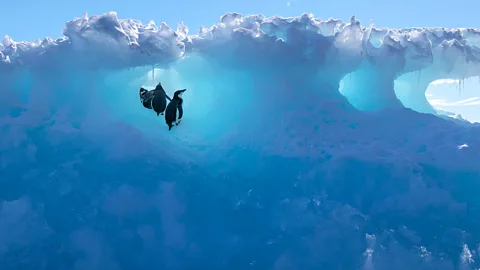 Getty Images
Getty ImagesIcebergs of the future
In many ways, A-68 was a microcosm of what to expect as Antarctica and other large ice sheets melt due to climate change.
For one thing, huge dumps of freshwater into the ocean can disrupt currents. "An individual iceberg is not going to make a difference," says Cenedese, but there is a vast amount of water locked up in Antarctica's ice. "All that water's going to get into the ocean." This is already happening around Antarctica's coast, but it is complicated by other processes. "It's easier to see what happens near an iceberg because it's small."
In response, Tarling is drawing up plans for larger-scale studies of icebergs, with the aim of understanding how they affect the ocean.
There have been other giant icebergs since A-68. Tarling says his team has already obtained data from two, "by pure luck": "We just happened to be in the area."
Iceberg A-74 calved from Antarctica in March 2021, just before A-68 collapsed, exposing a huge area of seabed that proved to be teeming with animals. A-76 emerged in May 2021. At the time it was the world's largest iceberg. Then in late 2023 came A-23a. It calved in 1986 but swiftly grounded in the Weddell Sea and stayed there for decades. The RRS Sir David Attenborough visited it in December 2023, and the following month another expedition obtained dramatic pictures of caves and arches sculpted into its side walls by waves. It is still largely intact.
These calving events can have drastic consequences for Antarctic wildlife. For instance, in May 2024 iceberg A-83 broke away from the Brunt Ice Shelf and drifted to a new position – which blocked access to the sea for an emperor penguin colony at Halley Bay. These penguins were already struggling: in 2019 it emerged they had failed to raise many chicks for three years in a row. The iceberg posed an additional threat.
It moved as the long Antarctic winter began, so the scientists had a long anxious wait before they could see what had became of the emperor penguins. In late September, Peter Fretwell at the British Antarctic Survey told BBC News that satellite photos had revealed "a brown smudge on the white ice sheet", indicating the colony had survived.
We need to understand such icebergs, says Tarling, because climate change is thawing Antarctica. "The probability of icebergs like this coming into Iceberg Alley," he says, "is greater and will be becoming greater." We can expect many more huge bergs like A-68.
--
For essential climate news and hopeful developments to your inbox, sign up to the Future Earth newsletter, while The Essential List delivers a handpicked selection of features and insights twice a week.
